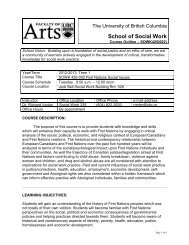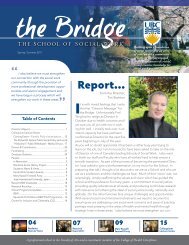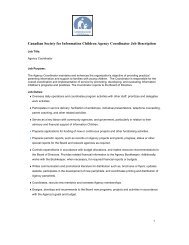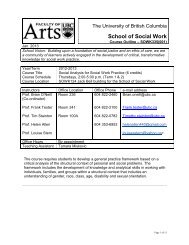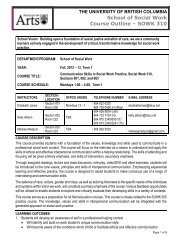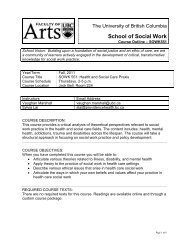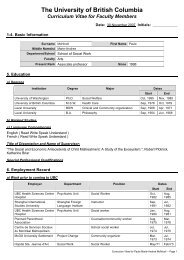Equity Case Studies Report - School of Social Work - University of ...
Equity Case Studies Report - School of Social Work - University of ...
Equity Case Studies Report - School of Social Work - University of ...
You also want an ePaper? Increase the reach of your titles
YUMPU automatically turns print PDFs into web optimized ePapers that Google loves.
UBC school <strong>of</strong> social work equity and diversity strategic plan: A compilation <strong>of</strong> case studies 76<br />
to acknowledge that as social and historic conditions are not equal for everyone, ‘equal<br />
opportunity’ is insufficient. As such, it is necessary to implement concepts <strong>of</strong> equity, which<br />
involves granting merit, ongoing support, and/or resources to individuals who have experienced<br />
(and continue to experience) social barriers (<strong>University</strong> <strong>of</strong> British Columbia <strong>School</strong> <strong>of</strong> <strong>Social</strong><br />
<strong>Work</strong> Educational <strong>Equity</strong> and Diversity Strategic Plan, 2011).<br />
Curriculum<br />
For <strong>School</strong>s <strong>of</strong> <strong>Social</strong> <strong>Work</strong> addressing equity and diversity in curricula, one <strong>of</strong> the<br />
questions that surface is: is it more beneficial to integrate equity into exiting curriculum, or to<br />
create separate courses on specific equity-related topics? From the examples in the individual<br />
case studies, it is apparent that there are benefits to incorporating both options – equity and<br />
diversity-inclusive curricula and required courses on equity issues, as well as additional electives<br />
on equity-related topics. However, when integrating equity-related material into curricula, it is<br />
essential that integration moves “beyond a token inclusion <strong>of</strong> content about diverse groups to a<br />
fundamental integration <strong>of</strong> different ways <strong>of</strong> knowing” (MacDonald et al., 2003, p. 481). The<br />
<strong>School</strong>s <strong>of</strong> <strong>Social</strong> <strong>Work</strong> in the individual case studies shared their processes in trying to move<br />
beyond such token inclusion. Each university employed several strategies, including<br />
collaboration between the <strong>Equity</strong>/Diversity Committees and the Curriculum Committees, active<br />
student participation in the construction and modifications <strong>of</strong> equity-related curricula, and<br />
consideration during the hiring process <strong>of</strong> candidates’ ability to integrate equity in their<br />
teachings. For example, Dalhousie’s <strong>School</strong> <strong>of</strong> <strong>Social</strong> <strong>Work</strong> endeavours to teach critical<br />
reflection, diversity, and anti-oppressive practice from a social justice perspective in every<br />
course they deliver, whether or not the course is specifically addressing an equity topic. This is



